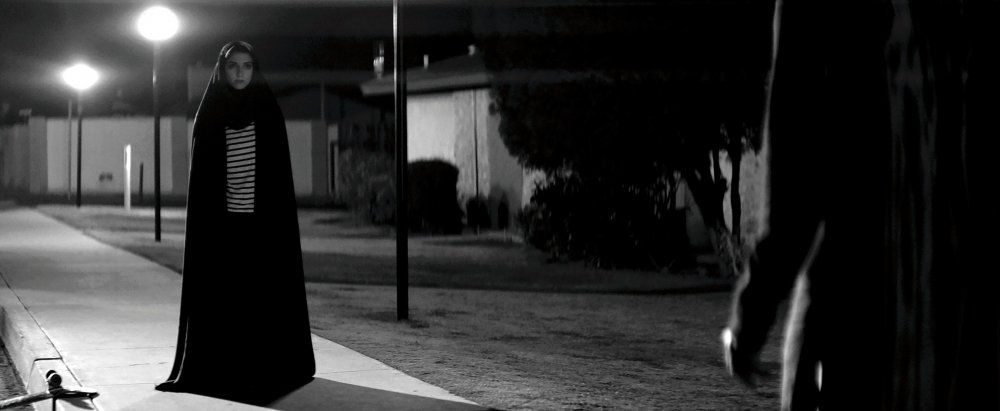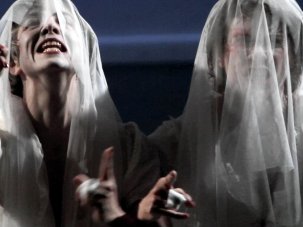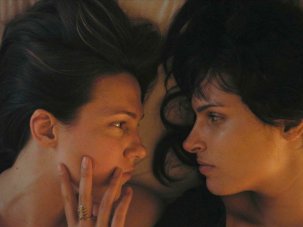In Ana Lily Amirpour’s debut feature A Girl Walks Home Alone at Night, the Girl (Sheila Vand) doesn’t just walk: sometimes she stands more still than humanly possible; sometimes she mimics an old man’s faltering steps; sometimes she takes off her chador and dances in her flat; sometimes she tears men’s throats out; and sometimes she skateboards. Conveying both human traits and vampiric otherness, Vand’s dancerly movements make perfect sense of Amirpour’s decision to shoot in anamorphic black and white: she is a creature from and of another time. Her movement across the wide screen, slowly sliding along the wall of a once grand building on her skateboard, even seems to still time.
USA 2014
Certificate 15 100m 47s
Director Ana Lily Amirpour
Cast
the girl Sheila Vand
Arash Arash Marandi
Atti, prostitute Mozhan Marnò
Hossein, junkie Marshall Manesh
Saeed, pimp Dominic Rains
street urchin Milad Eghbali
Shaydah, ‘the princess’ Rome Shadanloo
Rockabilly Reza Sixo Safai
cat Masuka
Black and White
[2.35:1]
Subtitles
UK release date 22 May 2015
Distributor Studiocanal Limited
► Trailer
She doesn’t just defy the clichéd consequences implied by the title through her powerful actions as a vampire; she also fills the frame with her implacable poise and depthless gaze. Appearing first as a silhouette in a full chador, she stands near a road-crossing sign invented by Amirpour as a visual joke, warning drivers to look out for chador-clad women. Once again, the meaning is reversed: walking home alone and wearing the veil are here not markers of vulnerability and lack of agency, but of occult power. Unlike the Girl (Veronica Lake) of Preston Sturges’s Sullivan’s Travels (1941), Amirpour’s Girl is not sidekick but superhero, an avenging angel whose first words in the film, spoken to a kid with a skateboard (which she takes), are “Are you a good boy?” Amoral but not immoral, the Girl kills local pimp Saeed (Dominic Rains) after he tries to hit on her, and later the old man Hossein (Marshall Manesh), after he forces Atti (Mozhan Marnò), one of Saeed’s sex workers, to shoot up with him.
At a Q&A at the BFI London Film Festival last October, Amirpour said that she wrote the film for Vand after the latter made an off-the-cuff comment that someone should cast her as a vampire. Although the film offers us a human male, Arash (“the Persian James Dean” in Amirpour’s words), as our apparent point-of-view character, it is the Girl who compels us through the desultory story and highly atmospheric world of Bad City, an Iranian town created in the California interior. Amirpour and her cast are part of the global Iranian diaspora, and the film has hints of homage to Iranian New Wave cinema, particularly in the knowing kid who drops his skateboard and later witnesses a fatal event.
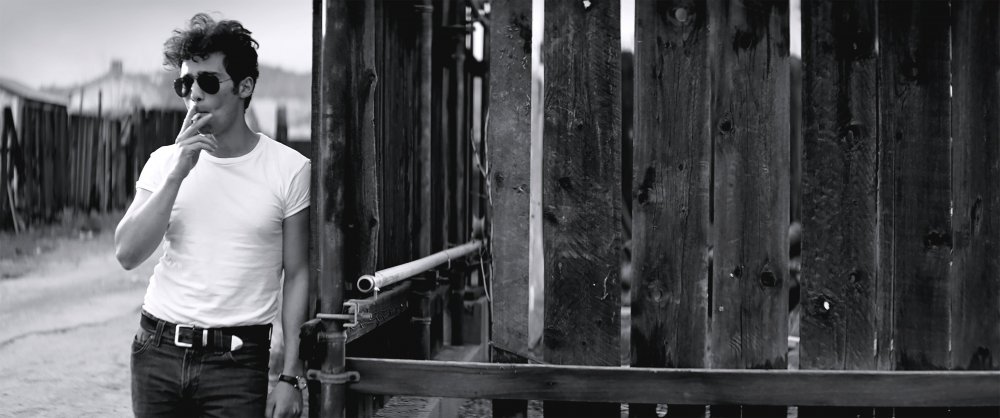
A Girl Walks Home Alone at Night (2014)
As many critics have noted, the film pays more obvious homage to the early work of Jim Jarmusch, as if sending the vampires of Only Lovers Left Alive (2013) back to the more marginal social worlds depicted in his Nicholas Ray/Sam Fuller-influenced Down by Law (1986). There’s a hint too of Gus Van Sant’s gritty, whacked-out Mala Noche (1986), his ‘bad night’ suggesting Amirpour’s Bad City. Unlike the work of these previous generations, however, Amirpour’s film has the crispness and finesse of a music video. Every gesture is choreographed, every frame is arresting, every sound edit perfectly placed. When it works – as in the long sequence from the meet cute between the Girl and a very stoned Arash, which makes great use of the tendency of the anamorphic lens to flare, or the moment when he approaches her in her apartment and time once again seems to slow down – this considered pace is arresting, but what works in moments of intensity can pall across the narrative arc.
The Girl-meets-boy narrative is foregrounded at the cost of more intriguing cameo characters: Arash Marandi has presence, but playing wounded hero Arash allows him none of the scope afforded to Rains, who gives an electric performance as Saeed. His preening, shirtless, iron-pumping attempt to seduce the Girl chimes with the observational sex comedy of that other film debut by an Iranian-American female filmmaker this year, Desiree Akhavan’s Appropriate Behavior. At this point the film also seems set for a showdown between the Girl and Shaydah (Rome Shadanloo), a bored rich kid whose family employs Arash as a handyman and who flirts with and then abandons him at a party – but soon this intriguing, well-drawn character drops out. Reza Sixo Safai’s character, the Rockabilly (combining a hijab with a fringed shirt and tight jeans to work the streets), is a welcome note of intrigue and randomness in a tightly controlled film, but his balloon dance – a homage to the dancing oddballs of David Lynch’s work – is so dislocated as to be almost an extradiegetic insert.
Beneath its polish and nouvelle vague-saluting cool (the Girl sports a Breton striped top), the film can sometimes seem to lack a beating heart: shot in black and white, it has to omit the shocking red that was such a potent contrast with white snow in Tomas Alfredson’s Let the Right One In (2008). When the Girl bites off Saeed’s finger and uses it to paint blood like lipstick on his lips, the monochrome allows the moment to come across as witty – but ironic rather than angry in its critique of gendered violence. It only seems plausible that Arash would subsequently walk straight past the Girl despite the bloodstains around her mouth if they actually lived in a black-and-white world in which no shade registers. This certainly tallies with the ennui and the empty streets, and the total lack of attention given to the roadside gully full of dozens of dead bodies that is the Girl’s dumping ground.
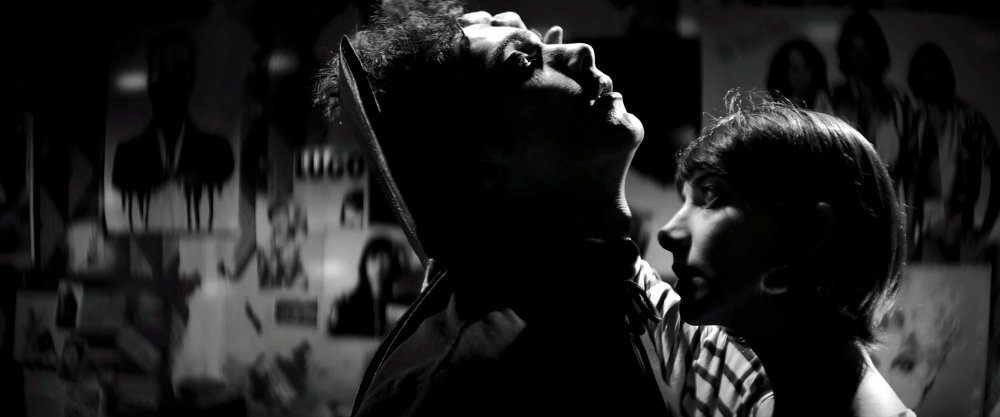
A Girl Walks Home Alone at Night (2014)
Or perhaps it’s an indication of the film’s true point-of-view character: the cat that Arash steals in the opening scene, and which steals the closing scene with a direct gaze to camera. Cats’ colour vision, while not strictly monochromatic, is far less vibrant than humans’ and, as hunters, their ethics may hew closer to the Girl’s than to that of people like the commentator Hossein sees on television, telling wives how to behave. Repeated extreme close-ups of the cat’s eyes bear out this sense of a cool, amoral feline worldview controlling the film, one that is frequently paralleled with the vampire’s: it’s notable that the Girl executes Saeed and Hossein, both of whom have been cruel to the cat. Cats are notoriously difficult to direct, and it’s Masuka the cat’s wayward and spontaneous performance that brings to the film some of the raw, vivid and slyly funny quality of Jarmusch or Van Sant’s more improvisational work.
But Masuka is not the only unpredictable, living element that enables the film to overcome the risk of glossy inertia: the atmospheric sound design by Jay Nierenberg is suggestive of the supernatural hearing of the vampire, as every inhalation of a cigarette crackles; the constant offscreen rumble of the trains that carry oil from the derricks of Bad City suggest at once the repetitive boredom of daily life and the possibility of a way out.
That comes through music: Amirpour, a singer and DJ, uses the soundtrack throughout with such verve and rhythm that the film moves towards being a musical. Arash’s CDs are the first things he packs when leaving town for ever, and the Girl seems taken with him solely because he responds to her love of music. With a DJ’s ear for a drop, Amirpour has the Girl tilt back Arash’s head, exposing his neck, to the lyric (from Death by White Lies): “I can feel my heart beating as I speed from/The sense of time catching up with me.” She places her ear against his chest, listening for the beat of life that music brings to this relentlessly elegant vampire’s-eye view of a film.
-
Sight & Sound: the June 2015 issue

Girlhood and the faces of the new French cinema – plus Clouds of Sils Maria, The New Girlfriend, the Tribe, Phoenix and the S&S Interview with...
-
The Digital Edition and Archive quick link
Log in here to your digital edition and archive subscription, take a look at the packages on offer and buy a subscription.




